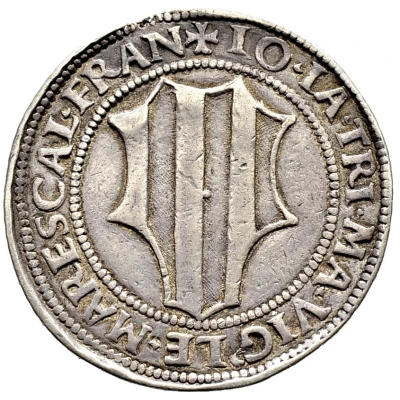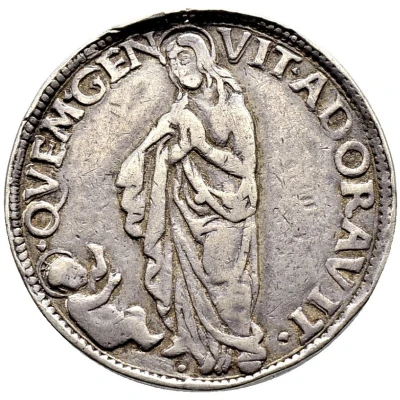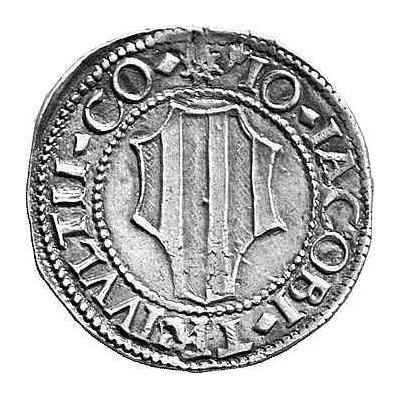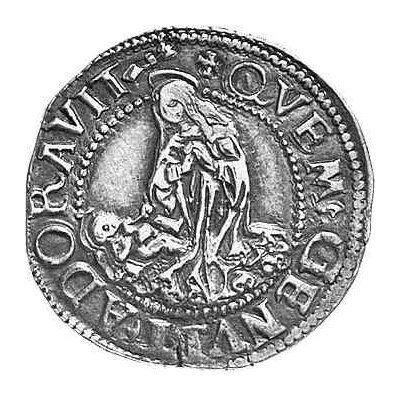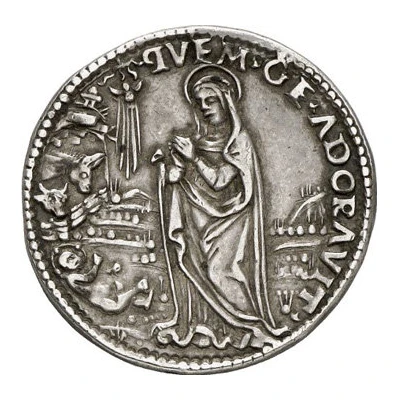
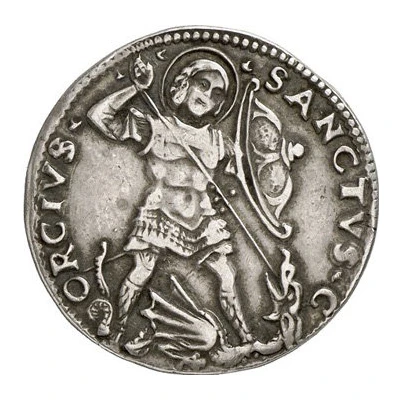

© Leu Numismatik
Testone - Johann Jakob Trivulzio ND
| Silver | 9.51 g | - |
| Issuer | Lordship of Mesocco (Grisons) |
|---|---|
| Lord | John Jacob Trivulzio (Gian Giacomo Trivulzio) (1480-1518) |
| Type | Standard circulation coin |
| Years | 1487-1518 |
| Value | 1 Testone |
| Currency | Testone (1487-1549) |
| Composition | Silver |
| Weight | 9.51 g |
| Shape | Round (irregular) |
| Technique | Hammered |
| Demonetized | Yes |
| Updated | 2024-10-07 |
| Numista | N#198327 |
|---|---|
| Rarity index | 100% |
Reverse
Nimbate saint George standing, slaying Dragon.
Script: Latin
Lettering: · SANCTVS · G ORGIVS ·
Comment
Unlisted. Only known copy.The coin corresponds to a testone with a weight of 9.51 g. The typical coin design of the early Trivulzio-Testoni was the depiction of the Virgin Mary, who adores the baby Jesus lying on the floor. Maria kneels in a first series, in a second edition with the extended title Margrave of Vigevano and Marshal of France (after 1499) Maria is shown standing. See Leu 94 (2002) No. 1499 and No. 1503. The inscription QVEM GENVIT ADORAVIT refers to the promise of the Archangel Gabriel. St. Georg on foot, who kills the dragon with a lance, can be found on the Nominal Grosso da 6 Soldi, as it was coined for Mesocco under Gian Giacomo (died 1518), but was continued in the same style after 1518 by Gian Francesco. Incorrect transcriptions such as GIORGIVS instead of Georgius or LE instead of ET and open letters A without a dash appear when embossed by Gian Giacomo Trivulzio. See Leu 94 (2002) No. 1507 and No. 1511. The change of government after the death of Gian Giacomo in 1518 to the young Gian Francesco could have given rise to the anonymous, but typical Trivulzio imprint. Another option is available: In 1512 Gian Giacomo was granted the right to mint by Musso on Lake Como by King Louis XII of France and established another mint there. Mintings in Musso after 1516 are documented, but have not yet been recognized as such. After the loss of Musso, coins continued to be minted there under the new ruler Gian Giacomo de'Medici of Milan. See Leu 94 (2002) No. 1507 and No. 1511. The change of government after the death of Gian Giacomo in 1518 to the young Gian Francesco could have given rise to the anonymous, but typical Trivulzio imprint. Another option is available: In 1512 Gian Giacomo was granted the right to mint by Musso on Lake Como by King Louis XII of France and established another mint there. Mintings in Musso after 1516 are documented, but have not yet been recognized as such. After the loss of Musso, coins continued to be minted there under the new ruler Gian Giacomo de'Medici of Milan. See Leu 94 (2002) No. 1507 and No. 1511. The change of government after the death of Gian Giacomo in 1518 to the young Gian Francesco could have given rise to the anonymous, but typical Trivulzio imprint. Another option is available: In 1512 Gian Giacomo was granted the right to mint by Musso on Lake Como by King Louis XII of France and established another mint there. Mintings in Musso after 1516 are documented, but have not yet been recognized as such. After the loss of Musso, coins continued to be minted there under the new ruler Gian Giacomo de'Medici of Milan. Another option is available: In 1512 Gian Giacomo was granted the right to mint for Musso on Lake Como by King Louis XII of France and established another mint there. Mintings in Musso after 1516 are documented, but have not yet been recognized as such. After the loss of Musso, coins continued to be minted there under the new ruler Gian Giacomo de'Medici of Milan. Another option is available: In 1512 Gian Giacomo was granted the right to mint for Musso on Lake Como by King Louis XII of France and established another mint there. Mintings in Musso after 1516 are documented, but have not yet been recognized as such. After the loss of Musso, coins continued to be minted there under the new ruler Gian Giacomo de'Medici of Milan. (source: LHS Numismatik AG, Auction 103 Catalog, 2009, Lot 619)
Interesting fact
One interesting fact about the Testone coin is that it was issued during the reign of Johann Jakob Trivulzio, who was a powerful condottiero, or mercenary captain, in Italy during the late 15th and early 16th centuries. Despite being a military leader, Trivulzio was also known for his patronage of the arts and his support for the Renaissance movement. This coin, which features an image of Trivulzio on one side and the coat of arms of the Lordship of Mesocco on the other, is a rare example of a coin issued during his rule and is highly sought after by collectors today.
